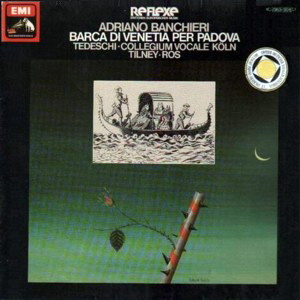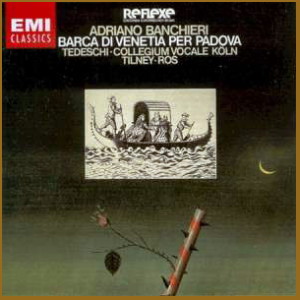 |
1 LP -
1C 063-30 128 Q - (p) 1976
|

|
| 1 CD - 8
26496 2 - (c) 2000 |
 |
1 CD -
CDM 7 63437 2 - (c) 1991
|
|
| ADRIANO
BANCHIERI (1567-1634) |
|
|
|
|
|
| Barca di
Venetia per Padova -
Dilettevoli Madrigali à cinque
voci |
|
|
|
|
|
| Introduttione |
|
|
| - L'Umor Svegliato |
1' 49" |
|
| - Strepito di
pescatori |
1' 57" |
|
| Partenza |
|
|
| - Parone di barca e
Ninetta |
2' 41" |
|
| - Barcaruolo à
Passagieri |
1' 20" |
|
| - Libraio Fiorentino |
1' 09" |
|
| - Maestro di Musica
Luchese |
1' 20" |
|
| - Concerto di cinque
cantori (Cinque cantori in diversi
lenguaggi) |
2' 40" |
|
| - Venetiano e
Thedesco |
1' 44" |
|
| Madrigale |
|
|
| - Madrigale
affettuoso |
3' 02" |
|
| - Madrigale
capriccioso |
3' 51" |
|
| - Madrigale in
dialogo |
1' 29" |
|
|
|
|
| - Dialogo |
2' 27" |
|
| Aplauso |
|
|
| - Mercante bresciano
et Hebrei |
1' 50" |
|
Madrigale
|
|
|
| - Stile del Marenzio
Romano (Madrigale alla Romana) |
2' 55" |
|
| - Madrigale à
imitazione del Spano Napolitano
(Madrigale alla Napolitana) |
2' 26" |
|
| - Prima Ottava
all'improvviso nel Liuto (Ottava
rima all'improvviso nel Liuto) |
1' 56" |
|
| - Seconda Ottava
all'improvviso nel Liuto |
2' 01" |
|
| - Aria à imitazione
del Radesca alla Piemontese nel
Liuto (Aria à imitazione del Radesca
nel liuto) |
2' 03" |
|
| - Barcaruoli
Procaccio e Tutti al fine
(Barcaruoli Procaccio e tutta la
Camerata) |
2' 07" |
|
| - Soldato
svaligiato |
2' 41" |
|
|
|
|
| Gianrico Tedeschi,
Sprecher |
|
|
|
| COLLEGIUM VOCALE
KÖLN |
|
| -
Michaela Krämer, Sopran |
|
| -
Gabz Ortmann-Rodens, Sopran |
|
| -
Helga Hamm-Albrecht, Mezzosopran |
|
| -
Wolfgang Fromme, Kontratenor |
|
| -
Helmut Clemens, Tenor |
|
| -
Hans-Alderich Billig, Baß |
|
| und |
|
| -
Colin Tilney, Cembalo |
|
| -
Pere Ros, Viola da Gamba und
Violine |
|
|
|
|
|
Luogo
e data di registrazione |
|
Burg
Konradsheim, Konradsheim
(Germania) - 1-4 ottobre 1975 |
|
|
Registrazione: live /
studio |
|
studio |
|
|
Producer / Engineer |
|
Gerd
Berg / Johann-Nikolaus Matthes |
|
|
Prima Edizione LP |
|
EMI
Electrola "Reflexe" - 1C 063-30
128 Q - (1 lp) - durata 43' 28" -
(p) 1976 - Analogico (Quadraphonic) |
|
|
Prima Edizione CD |
|
EMI
"Classics" - CDM 7 63437 2 - (1
cd) - durata 43' 28" - (c) 1991 -
ADD |
|
|
Edizione CD |
|
EMI
"Classics" - 8 26496 2 - (1 cd) -
durata 43' 28" - (c) 2000 - ADD |
|
|
Note |
|
La prima
edizione in CD contiene madrigali
di Gesualdo e Monteverdi
registrati nel 1974 e pubblicati
nel 1975 (estranei alla collana
Reflexe).
|
|
|
|
|
|
 In the days when
the only way of getting to and
from the Beaver Republic
of Venice was by water, the
favourite route was the one
linking Venice and Padua.
Thanks to the scenic charm of
the journey, but also to the
original company that could be
found amongst the passengers,
the trip on the burchiello
became a remarkable
experience, of which a number
of accounts were written inthe
course of the centuries. It is
therefore likely that this
experience also inspired Pater
Adriano Banchieri, a monk of
Monte Oliveto (near Bologna),
to render it in music when he
went to Venice in 1605 to take
on the post of organist for a
short period at the Convent of
St Helena. In the days when
the only way of getting to and
from the Beaver Republic
of Venice was by water, the
favourite route was the one
linking Venice and Padua.
Thanks to the scenic charm of
the journey, but also to the
original company that could be
found amongst the passengers,
the trip on the burchiello
became a remarkable
experience, of which a number
of accounts were written inthe
course of the centuries. It is
therefore likely that this
experience also inspired Pater
Adriano Banchieri, a monk of
Monte Oliveto (near Bologna),
to render it in music when he
went to Venice in 1605 to take
on the post of organist for a
short period at the Convent of
St Helena.
An important musician,
theorist and writer, Banchieri
was born at Bologna on 3rd
September 1568. His real name
was Tommaso: Adriano was the
name he adopted on entering
his order, which he did at the
age of 19. After receiving
instruction in music since
childhood, he became a pupil
of the highly regarded
Gioseffo Guami at Lucca,
probably in 1592 or 1593.
After organist’s posts at
Imola, Gubbio, Venice and
Verona, he finally returned to
his home town in 1606. There
he associated with many
distinguished musicians and
was the focus of a circle
which formed itself into two
Academies, one after the
other; until 1628, Banchieri
was the Principal of the
second. Hampered in his work
by failing eyesight during the
last years of his life,
Banchieri died of a stroke at
Bologna in 1634.
The Barca di Venetia per
Padova first appeared in
Venice in 1605, but this
version is only incompletely
preserved. The revision
published in 1623 has
considerable differences from
the first edition. Where the
overall disposition is
concerned, the first eight and
the last two numbers stay
where they were. Between them
there were originally two
separate scenes, which were
dovetailed together in the
second version: first, five
consecutive madrigals, and
then the Rizzolina episode.
The madrigals were reduced to
four, of which only two were
from the first edition and
even they were rearranged. The
Rizzolina
episode, on the other hand,
was arnplified
somewhat. In addition,
far-reaching textual
and musical alterations were
made to the various pieces.
The gift for acute observation
and characterisation, and for
formulating them in elegant or
barbed terms, which marks the
wit of the Italian
Renaissance, is also typical
of the humorous works of
Adriano Banchieri to a high
degree. However vivid or, as
quite often drastic the
depiction of the characters
and action may be, the
musical treatment is always
given its full value.
The Umore, who calls
upon both actors and public
alike (I), is often quoted as
an example of this. As with
nearly all the figures who
appear in such works, the
depiction of Umore is
not tied to a particular
voice: the whole company sings
his words, every phrase (and
also individual ideas) being
given its own motif in the
traditional manner according
to what the words express.
The description of the
fishermen and oarsmen on the
Venetian shore (II) is
a fine example of the
aforementioned balance between
vivid illustration and formal
control: the three parts (the
first is repeated after the
second) are written above the
cry of the fishermen (Ostreghe
da bruazzo, etc) which
is sung three times unchanged
as a cantus firmus. Amid the
cries of the crew, the Patrono
takes leave of his Ninetta (III),
with the madrigalesque
emotionalism of the lover’s
complaint in caricaturing
contrast to the setting. The
joyful conclusion in triple
time is the signal for the
company to set off. The
Patrono eggs on the passengers
to pass the time with
amusements (IV); the nasal
syllables here and elsewhere
(e.g. ba - nanana - rca)
are probably a caricature of a
particular manner of singing,
and maybe of the Venetian
dialect as well.
Then a bookseller from
Florence proposes (V) that
tive singers - the normal
contingent for the vocal
chamber music of that day -
volunteer to perform alcune
cappricciate del Banchieri.
A singing teacher from Lucca
(possibly a reminiscence of
Banchieri’s period of study
there) seconds the proposal
(VI), chiming
in with the solfeggio scales
that were always the attribute
of singers until well into the
19th century. The five singers
are got together (VII) - four
Italians from various regions,
and a German capable of broken
Italian. One after another
they introduce themselves,
each in his own dialect and
with his own manner of
singing. The witty
juxtaposition of dialects had
been a set custom since the
14th century, and the picture
of the tippling Northerner was
also part of the permanent
repertoire. The following
number (VIII), like No II, is
written above the cantus
tirmus (repeated four times)
of the quaffing German, who
begins and ends it by himself,
lurching along as it were
musically too. Two seriously
meant madrigals follow (IX-X)
in the style of Carlo Gesualdo
da Venosa; later on, others in
the manner of Luca Marenzio
(XIV) and Donato Antonio Spano
(IV), a Neapolitan
contemporary of Banchieri. Yet
another piece is modelled on
Enrico Radesca,
of Turin. How
these allusions are to be
understood, however, is hard
to explain satisfactorily.
They can scarcely be intended
as superficial imitations,
still less as parodies, as one
would then expect hard
chromatic progressions in the
case of Gesualdo, an opening
with accentuated exclamation
in the case of Marenzio, and
so on. At all events,
Banchieri employs the madrigal
style of his day, with much
use of the diminished fourths
generally
associated with lovers’
complaints (already parodied
in No III)
and with texts partly by the
popular Giovanni Battista
Guarini.
The madrigal scene is
interrupted and then submerged
by the merry goings-on
centring on the fair
Rizzolina. The first ot these
scenes (XI-XIII) is
held together by the balletto
retrain Fa-la-la
or La-trai-nai-nai. Rizzolina
is presented first on her own,
as a kind of precentor
answered by the chorus (in the
manner of the French airs de
cour); then with her lover
Orazio in a duet for upper and
lower voices. A Jewish couple
who have come aboard say their
prayers, singing the Hebrew
texts (which are in part
only suggested in sound) in
canon, while the tenor keeps
repeating the vvord la
sinagoga
as a kind of cantus firmus.
The second Rizzolina scene
begins (XVI-XVII) with eight
verses of a song, of which
four
are sung by Rizzolina and four
by Orazio, while the remaining
four
voices (the soloist who is not
at the moment acting as
precentor sings the uppermost
part) imitate the lute
accompaniment with
onomatopoeic syllables. When,
finally, a string breaks, the
“lute” accompaniment in the
next piece (XVIII) is reduced
to three voices, as the two
soloists sing four more verses
(each sings the same one
twice), again in canon.
Arrival, payment of the fare,
and disembarkation, are
rounded off (XIX) with the
balletto refrain (already
familiar from Nos XI and
XIII), which also concludes
the actual voyage.
The Epilogue, with the begging
of the fake soldier (XX), may
allude to actual events, as
many Italians served in the
Emperors campaigns against the
Turks.
Theophil
Antonicek
(Translation:
David Potter)
|
|
|
EMI Electrola
"Reflexe"
|
|
|
|

